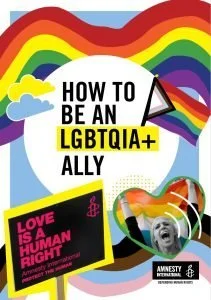The answers revealed
Keep an eye on your phone – we’ll be in touch to send you your LGBTQIA+ ally guide!

This guide presents simple and practical advice for all of us, as we strive to better support the LGBTQIA+ people in our lives and challenge discrimination facing the LGBTQIA+ community. Together, we can help build a safer, kinder and more equal world where human rights are enjoyed by all, regardless of who we love, how we dress or how we identify.
Question 1: Fill in the blank: “I just met Jo. I don’t know what __ pronouns are.”
Answer: C. Their. Always refer to someone with they/them pronouns when you don’t know their gender identity.
Question 2: Jamie is a transgender man. Is it certain that Jamie’s pronouns are he/him?
Answer: B. Not necessarily. Some transgender men will use he/him pronouns while others may use they/them, other pronouns, or a combination. It’s best to never assume what pronouns someone uses.
Question 3: True or False?: Aliyah’s social media profile says ‘Aliyah (she/they)’, meaning that you should refer to Aliyah only as ‘she’.
Answer: B. False. Aliyah’s social media profile says ‘Aliyah (she/they)’, meaning that you should refer to Aliyah with the pronouns ‘she’ and ‘they’ interchangeably.
Question 4: Tao introduces himself to you. He says “I’m Tao and my pronouns are he/him.” Does this mean that Tao is part of the LGBTQIA+ community?
Answer: A. Tao is not necessarily part of the LGBTQIA+ community. By sharing his pronouns with you, he is simply telling you how you can refer to him.
Everyone uses pronouns, regardless of their gender identity or sexual orientation, Pronouns are how we refer to someone with language other than their name (e.g. they/them, he/him, she/they, ze/zir, xe/xir). Everyone can share their pronouns, whether they are part of the LGBTQIA+ community or not.
Sharing your pronouns with other people lets them know how to refer to you. It also helps to create a culture that is more inclusive and acknowledges the diversity of gender identities that exist, and doesn’t assume people’s pronouns.
Question 5: How can you learn what someone’s pronouns are?
Answer: E. All of the above. You can learn what someone’s pronouns are by checking their social media profile or email signature (this is typically where people would specify their pronouns). You can also try listening to how other people close to that person refer to them. You can also respectfully ask somebody what pronouns they use.
You are part of a movement defending equality and demanding safety for all.
From all of us at Amnesty, thank you. Your support as an ally is changing lives.